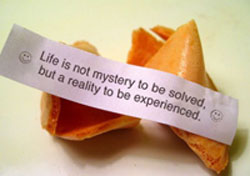
Fortune Cookies - Facts & History
Anyone who has been to a Chinese restaurant has had, or at least seen, fortune cookies. These almond or vanilla flavored treats not only taste great, but they have a surprise inside – a small strip of paper with a prediction or saying printed on it. The fortune cookie is a cookie with a piece of paper inside with words of supposed wisdom and/or prophecy.
The issue has become so contentious that it fueled a 1983 court battle where a judge decided that the modern fortune cookie came from San Fransisco.
Theories abound to the origin of the fortune cookie, but what is certain is that no matter how the cookie originated, the fortune cookie in its present form originated in pre-World War I California.
Theory 1:
It is believed that fortune cookies first appeared in the United States in 1914, made by Makoto Hagiwara, a Japanese man in San Francisco. He owned the business that is now known as the Golden Gate Park Japanese Tea Garden and served the cookies with tea.
Theory 2:
In Japan, centuries-old small family bakeries make an obscure fortune cookie-shaped crackers by hand near a temple outside Kyoto. An illustration from a 1878 book of stories, “Moshiogusa Kinsei Kidan”, shows wafers being grilled over coals and little pieces of paper were folded between the cookies before they cooled. The cookies are called: tsujiura senbei (“fortune crackers”), omikuji senbei (“written fortune crackers”), and suzu senbei (“bell crackers”). In an earlier work of Japanese fiction by Tamenaga Shunsui (1790 - 1843), a woman tries to placate two other women with tsujiura senbei that contain fortunes. Flavored with sesame and miso, the cookies are larger and browner than their American cousins, and the little paper fortunes are found on the outside . This inspired Japanese Americans to invent the modern fortune cookie as we know it.
Theory 3:
However, there is another belief that the cookies did not make their first American appearance until 1918, when the Chinese-American man David (Tsung) Jung, who also owned the Hong Kong Noodle Company in Los Angeles, began serving cookies stuffed with biblical passages to his customers.
Theory 4:
For many centuries the Chinese have marked special occasions and festival times such as harvest and New Year with the giving and receiving of Moon Cakes these were made from Lotus Nut Paste. During the 13th and 14th centuries China was occupied by the Mongols. When plans were made in Peking for a popular uprising to oust the invaders, much thought was given how news of the date of the uprising could be circulated without alerting the Mongols. The story goes that the Mongols had no taste for Lotus Nut Paste and so the Chinese hid the message containing the date in the middle of their Moon Cakes replacing the yolk with secret messages. Patriotic revolutionary, Chu Yuan Chang took on the disguise of a Taoist priest and entered occupied walled cities handing out Moon Cakes. These were the instructions to co-ordinate the uprising which successfully formed the basis of the Ming Dynasty.
Thus the tradition of giving cakes with messages was born and became a popular way of expressing wishes of goodwill or good fortune on an important occasion.
The 49er theory also originates in northern California. In the mid-1800s, many Chinese immigrants worked to build the country's railways in Nevada and Canada. They wanted to celebrate the Moon Festival, a holiday where it is customary to give special cakes with messages inside. Seeing as they had only biscuits, they improvised and created the fortune cookie.
The Fortune Cookie comes to main street USA:
Up until World War II fortune cookies where mainly popular in San Francisco area restaurants. Soldiers returning from World War II , would go to their local Chinese restaurants and inquire as to why they did not serve the same cookies that the shops in San Francisco did. A number of Americanized Chinese restaurants copied the idea and fortune cookies became very popular. Mainly served as a dessert after every meal at many restaurants. In addition to a fortune, fortune cookies may also contain lucky numbers (used by some as lottery numbers) and a Chinese phrase with translation.
The first automated production of Fortune Cookies took place in America in 1964 before that they were made by hand.
Although they are served almost exclusively in Chinese restaurants abroad, fortune cookies are almost unknown in China. Places that serve them call them "Genuine American Fortune Cookies."
Fortune cookies were actually invented in America, not China!
Learn how to make homemade Fortune Cookies - http://www.wikihow.com/Make-a-Fortune-Cookie
Sources:
http://www.123chinesenewyear.com/fortune-cookies/
http://en.wikipedia.org/wiki/Fortune_cookie
http://en.wikipedia.org/wiki/Court_of_Historical_Review
http://www.nytimes.com/2008/01/16/dining/16fort.html?_r=2
http://www.infoplease.com/spot/fortunecookies.html